Comprehensive Analysis of Tata Group's Management and Organization
VerifiedAdded on 2023/01/23
|10
|2581
|48
Report
AI Summary
This report provides a comprehensive analysis of the Tata Group's management and organization, examining its history, leadership styles, and strategic decisions. The report begins with an introduction to the Tata Group, a multinational conglomerate of Indian origin, and its evolution since its founding in 1868. It explores the significant changes in the organization's operations after India's independence, including diversification, globalization, and expansion through mergers and acquisitions. The analysis delves into the management processes implemented by the Tata Group, highlighting its commitment to CSR and its shift from a Western management perspective to a more human-centered approach. The report also discusses the current CEO's focus on synergy, simplification, and scale, as well as the changes in organizational structure. Finally, it examines the leadership styles of successive chairmen, emphasizing their democratic approach and the importance of ethics and values. The report concludes by summarizing the key factors contributing to the Tata Group's success, including its strong employee and community support, and its stable leadership approach.

Running head: MANAGEMENT AND ORGANIZATION
MANAGEMENT AND ORGANIZATION
Name of the Student
Name of the University
Author Note
MANAGEMENT AND ORGANIZATION
Name of the Student
Name of the University
Author Note
Paraphrase This Document
Need a fresh take? Get an instant paraphrase of this document with our AI Paraphraser
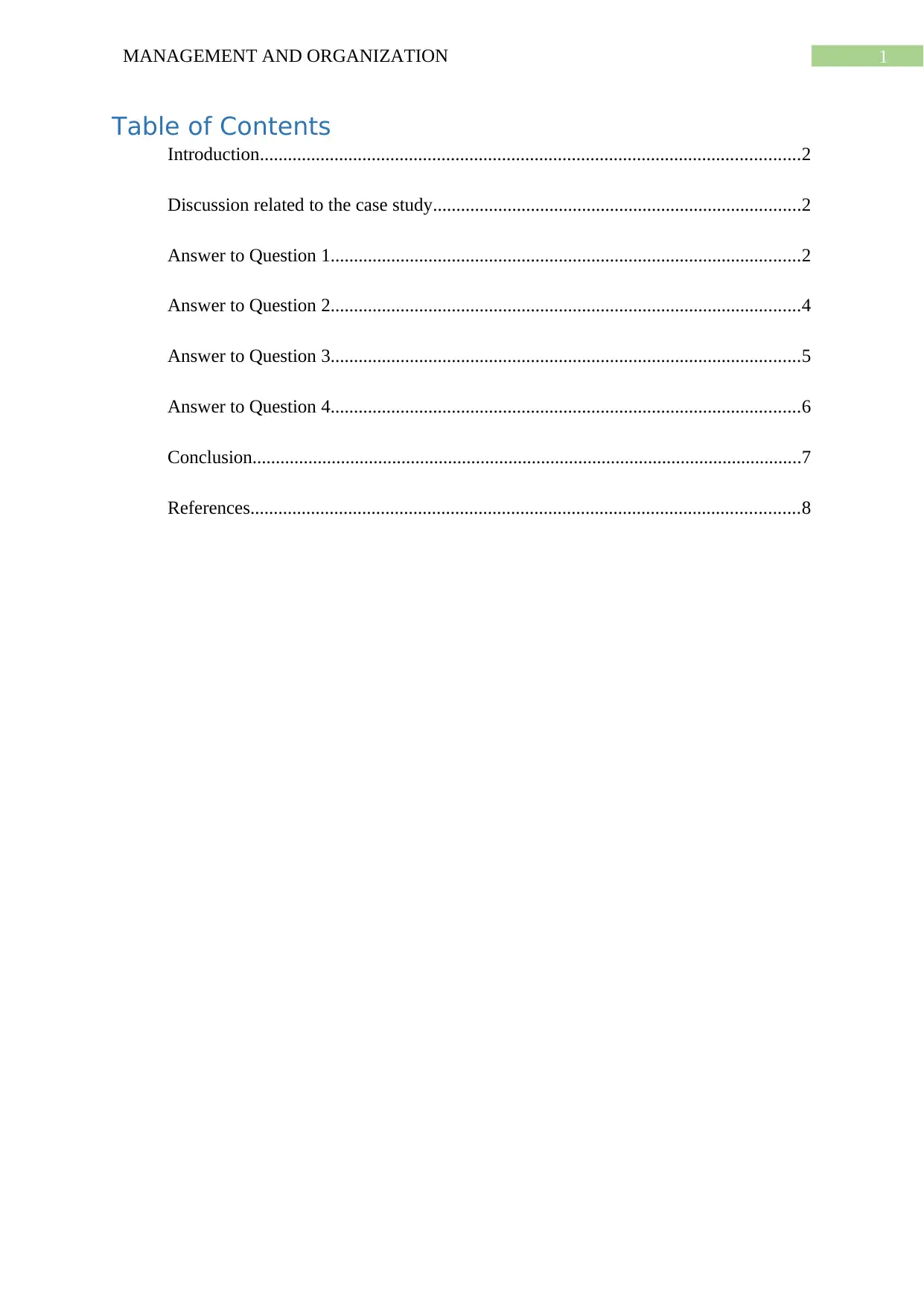
1MANAGEMENT AND ORGANIZATION
Table of Contents
Introduction....................................................................................................................2
Discussion related to the case study...............................................................................2
Answer to Question 1.....................................................................................................2
Answer to Question 2.....................................................................................................4
Answer to Question 3.....................................................................................................5
Answer to Question 4.....................................................................................................6
Conclusion......................................................................................................................7
References......................................................................................................................8
Table of Contents
Introduction....................................................................................................................2
Discussion related to the case study...............................................................................2
Answer to Question 1.....................................................................................................2
Answer to Question 2.....................................................................................................4
Answer to Question 3.....................................................................................................5
Answer to Question 4.....................................................................................................6
Conclusion......................................................................................................................7
References......................................................................................................................8
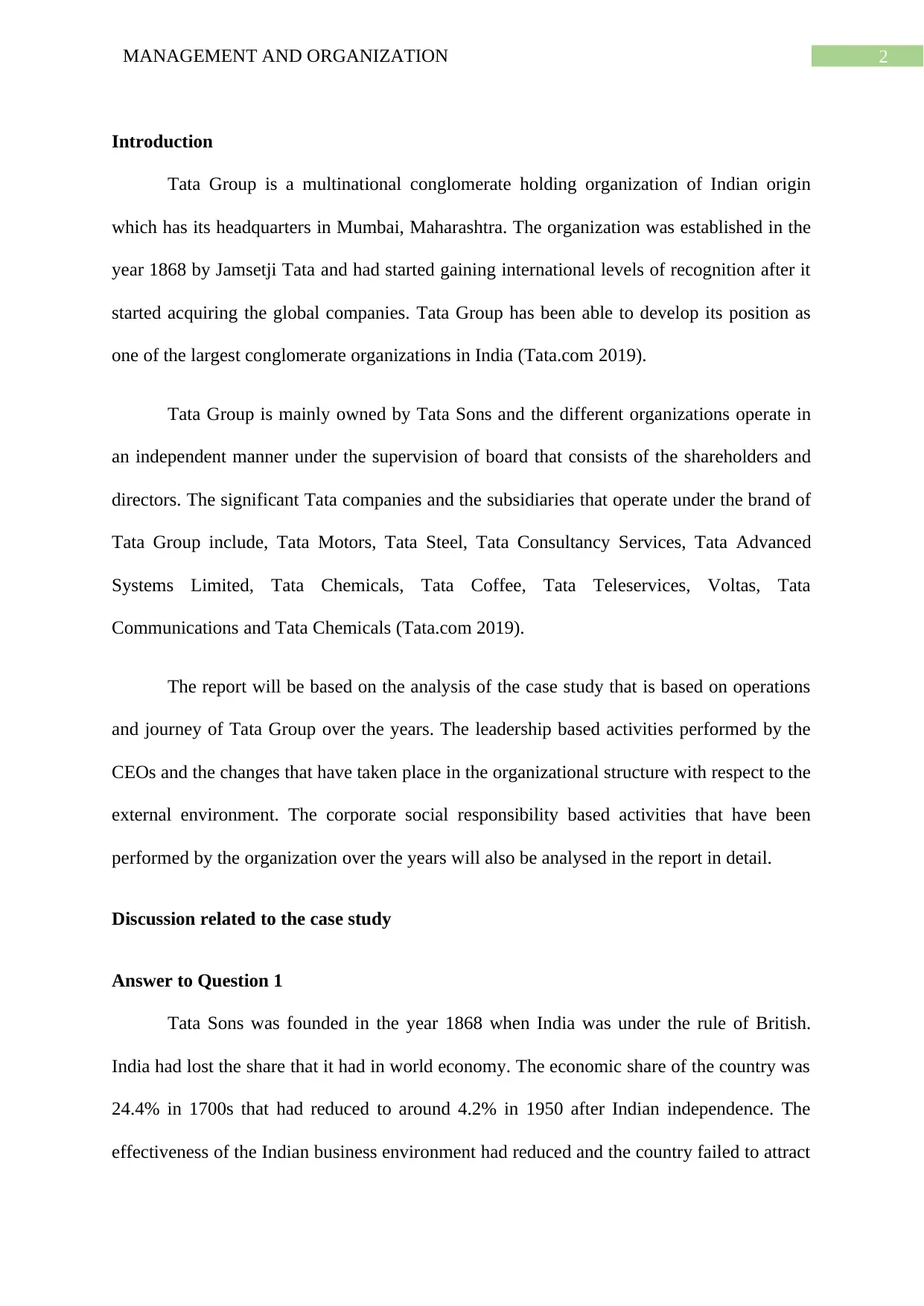
2MANAGEMENT AND ORGANIZATION
Introduction
Tata Group is a multinational conglomerate holding organization of Indian origin
which has its headquarters in Mumbai, Maharashtra. The organization was established in the
year 1868 by Jamsetji Tata and had started gaining international levels of recognition after it
started acquiring the global companies. Tata Group has been able to develop its position as
one of the largest conglomerate organizations in India (Tata.com 2019).
Tata Group is mainly owned by Tata Sons and the different organizations operate in
an independent manner under the supervision of board that consists of the shareholders and
directors. The significant Tata companies and the subsidiaries that operate under the brand of
Tata Group include, Tata Motors, Tata Steel, Tata Consultancy Services, Tata Advanced
Systems Limited, Tata Chemicals, Tata Coffee, Tata Teleservices, Voltas, Tata
Communications and Tata Chemicals (Tata.com 2019).
The report will be based on the analysis of the case study that is based on operations
and journey of Tata Group over the years. The leadership based activities performed by the
CEOs and the changes that have taken place in the organizational structure with respect to the
external environment. The corporate social responsibility based activities that have been
performed by the organization over the years will also be analysed in the report in detail.
Discussion related to the case study
Answer to Question 1
Tata Sons was founded in the year 1868 when India was under the rule of British.
India had lost the share that it had in world economy. The economic share of the country was
24.4% in 1700s that had reduced to around 4.2% in 1950 after Indian independence. The
effectiveness of the Indian business environment had reduced and the country failed to attract
Introduction
Tata Group is a multinational conglomerate holding organization of Indian origin
which has its headquarters in Mumbai, Maharashtra. The organization was established in the
year 1868 by Jamsetji Tata and had started gaining international levels of recognition after it
started acquiring the global companies. Tata Group has been able to develop its position as
one of the largest conglomerate organizations in India (Tata.com 2019).
Tata Group is mainly owned by Tata Sons and the different organizations operate in
an independent manner under the supervision of board that consists of the shareholders and
directors. The significant Tata companies and the subsidiaries that operate under the brand of
Tata Group include, Tata Motors, Tata Steel, Tata Consultancy Services, Tata Advanced
Systems Limited, Tata Chemicals, Tata Coffee, Tata Teleservices, Voltas, Tata
Communications and Tata Chemicals (Tata.com 2019).
The report will be based on the analysis of the case study that is based on operations
and journey of Tata Group over the years. The leadership based activities performed by the
CEOs and the changes that have taken place in the organizational structure with respect to the
external environment. The corporate social responsibility based activities that have been
performed by the organization over the years will also be analysed in the report in detail.
Discussion related to the case study
Answer to Question 1
Tata Sons was founded in the year 1868 when India was under the rule of British.
India had lost the share that it had in world economy. The economic share of the country was
24.4% in 1700s that had reduced to around 4.2% in 1950 after Indian independence. The
effectiveness of the Indian business environment had reduced and the country failed to attract
⊘ This is a preview!⊘
Do you want full access?
Subscribe today to unlock all pages.

Trusted by 1+ million students worldwide
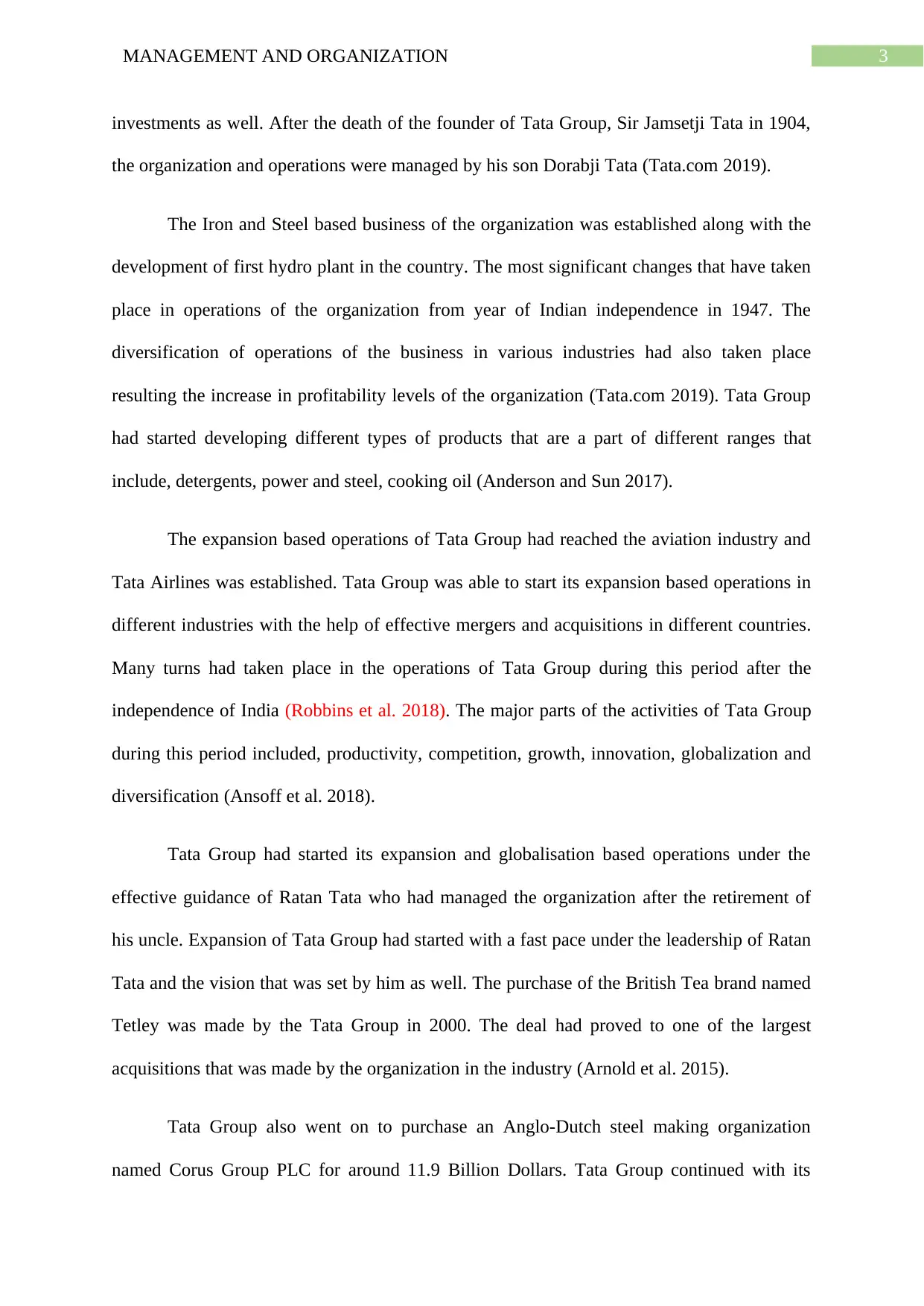
3MANAGEMENT AND ORGANIZATION
investments as well. After the death of the founder of Tata Group, Sir Jamsetji Tata in 1904,
the organization and operations were managed by his son Dorabji Tata (Tata.com 2019).
The Iron and Steel based business of the organization was established along with the
development of first hydro plant in the country. The most significant changes that have taken
place in operations of the organization from year of Indian independence in 1947. The
diversification of operations of the business in various industries had also taken place
resulting the increase in profitability levels of the organization (Tata.com 2019). Tata Group
had started developing different types of products that are a part of different ranges that
include, detergents, power and steel, cooking oil (Anderson and Sun 2017).
The expansion based operations of Tata Group had reached the aviation industry and
Tata Airlines was established. Tata Group was able to start its expansion based operations in
different industries with the help of effective mergers and acquisitions in different countries.
Many turns had taken place in the operations of Tata Group during this period after the
independence of India (Robbins et al. 2018). The major parts of the activities of Tata Group
during this period included, productivity, competition, growth, innovation, globalization and
diversification (Ansoff et al. 2018).
Tata Group had started its expansion and globalisation based operations under the
effective guidance of Ratan Tata who had managed the organization after the retirement of
his uncle. Expansion of Tata Group had started with a fast pace under the leadership of Ratan
Tata and the vision that was set by him as well. The purchase of the British Tea brand named
Tetley was made by the Tata Group in 2000. The deal had proved to one of the largest
acquisitions that was made by the organization in the industry (Arnold et al. 2015).
Tata Group also went on to purchase an Anglo-Dutch steel making organization
named Corus Group PLC for around 11.9 Billion Dollars. Tata Group continued with its
investments as well. After the death of the founder of Tata Group, Sir Jamsetji Tata in 1904,
the organization and operations were managed by his son Dorabji Tata (Tata.com 2019).
The Iron and Steel based business of the organization was established along with the
development of first hydro plant in the country. The most significant changes that have taken
place in operations of the organization from year of Indian independence in 1947. The
diversification of operations of the business in various industries had also taken place
resulting the increase in profitability levels of the organization (Tata.com 2019). Tata Group
had started developing different types of products that are a part of different ranges that
include, detergents, power and steel, cooking oil (Anderson and Sun 2017).
The expansion based operations of Tata Group had reached the aviation industry and
Tata Airlines was established. Tata Group was able to start its expansion based operations in
different industries with the help of effective mergers and acquisitions in different countries.
Many turns had taken place in the operations of Tata Group during this period after the
independence of India (Robbins et al. 2018). The major parts of the activities of Tata Group
during this period included, productivity, competition, growth, innovation, globalization and
diversification (Ansoff et al. 2018).
Tata Group had started its expansion and globalisation based operations under the
effective guidance of Ratan Tata who had managed the organization after the retirement of
his uncle. Expansion of Tata Group had started with a fast pace under the leadership of Ratan
Tata and the vision that was set by him as well. The purchase of the British Tea brand named
Tetley was made by the Tata Group in 2000. The deal had proved to one of the largest
acquisitions that was made by the organization in the industry (Arnold et al. 2015).
Tata Group also went on to purchase an Anglo-Dutch steel making organization
named Corus Group PLC for around 11.9 Billion Dollars. Tata Group continued with its
Paraphrase This Document
Need a fresh take? Get an instant paraphrase of this document with our AI Paraphraser

4MANAGEMENT AND ORGANIZATION
expansion based operations in the automobile based industry as well with the help of
acquisition of Jaguar and Land Rover from Ford Motor. Major changes which have been
made in Tata Group’s operations are related to the increase in levels of international
expansion (Robbins et al. 2018). International presence of Tata Group has increased in a huge
manner in the last few years due to different acquisition and merger based operations that
have been performed (Cashman 2017). The organization had started operating in India as a
small trading based firm and later expanded its operations in many industries with the support
that was provided by the merger and acquisition based activities. The structure of the
organization however remained the same during so many years of its successful operations in
different countries (Covin and Slevin 2017).
Answer to Question 2
The process of management that had been initially implemented by Tata Group had
gone through many changes in various areas of its operations in various industries. The
business that had been started by Tata Group in the industry had an impact on the ways by
which the economy of a nation can be developed effectively. The effective diversification of
operations of the business had led to the growth of Tata Group in India and in different parts
of the world as well (Grint, Jones and Holt 2016).
The application of new and improved technologies had been a major concern of the
organization in the development proper partnerships formed by Tata Group. The needs and
demands of people have been provided with major levels of importance by Tata Group. The
success that has been gained by Tata Group in the industry is also totally based on the support
that is gained by the organization from employees and the other individuals in the industry
(Heifetz and Linsky 2017).
expansion based operations in the automobile based industry as well with the help of
acquisition of Jaguar and Land Rover from Ford Motor. Major changes which have been
made in Tata Group’s operations are related to the increase in levels of international
expansion (Robbins et al. 2018). International presence of Tata Group has increased in a huge
manner in the last few years due to different acquisition and merger based operations that
have been performed (Cashman 2017). The organization had started operating in India as a
small trading based firm and later expanded its operations in many industries with the support
that was provided by the merger and acquisition based activities. The structure of the
organization however remained the same during so many years of its successful operations in
different countries (Covin and Slevin 2017).
Answer to Question 2
The process of management that had been initially implemented by Tata Group had
gone through many changes in various areas of its operations in various industries. The
business that had been started by Tata Group in the industry had an impact on the ways by
which the economy of a nation can be developed effectively. The effective diversification of
operations of the business had led to the growth of Tata Group in India and in different parts
of the world as well (Grint, Jones and Holt 2016).
The application of new and improved technologies had been a major concern of the
organization in the development proper partnerships formed by Tata Group. The needs and
demands of people have been provided with major levels of importance by Tata Group. The
success that has been gained by Tata Group in the industry is also totally based on the support
that is gained by the organization from employees and the other individuals in the industry
(Heifetz and Linsky 2017).
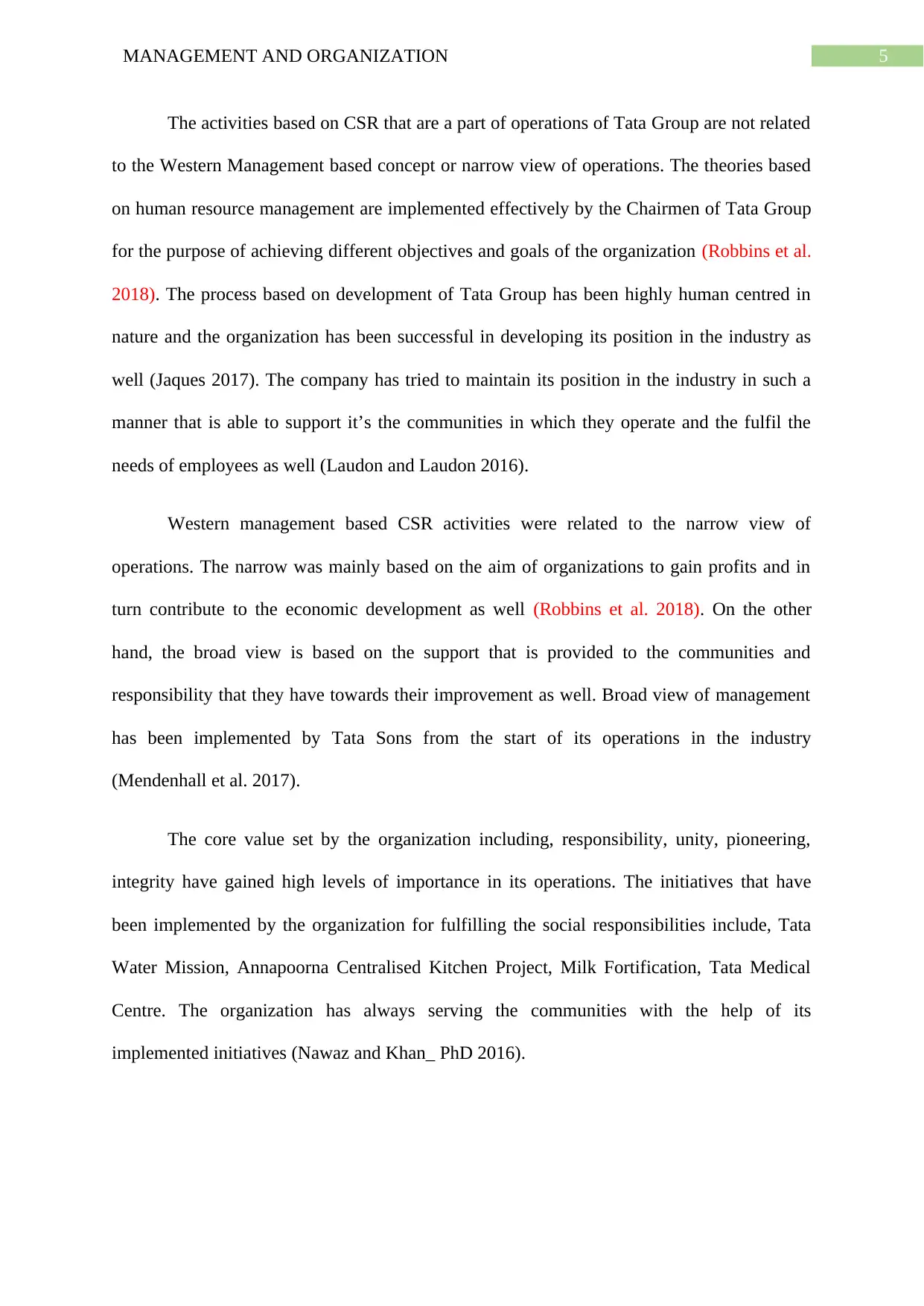
5MANAGEMENT AND ORGANIZATION
The activities based on CSR that are a part of operations of Tata Group are not related
to the Western Management based concept or narrow view of operations. The theories based
on human resource management are implemented effectively by the Chairmen of Tata Group
for the purpose of achieving different objectives and goals of the organization (Robbins et al.
2018). The process based on development of Tata Group has been highly human centred in
nature and the organization has been successful in developing its position in the industry as
well (Jaques 2017). The company has tried to maintain its position in the industry in such a
manner that is able to support it’s the communities in which they operate and the fulfil the
needs of employees as well (Laudon and Laudon 2016).
Western management based CSR activities were related to the narrow view of
operations. The narrow was mainly based on the aim of organizations to gain profits and in
turn contribute to the economic development as well (Robbins et al. 2018). On the other
hand, the broad view is based on the support that is provided to the communities and
responsibility that they have towards their improvement as well. Broad view of management
has been implemented by Tata Sons from the start of its operations in the industry
(Mendenhall et al. 2017).
The core value set by the organization including, responsibility, unity, pioneering,
integrity have gained high levels of importance in its operations. The initiatives that have
been implemented by the organization for fulfilling the social responsibilities include, Tata
Water Mission, Annapoorna Centralised Kitchen Project, Milk Fortification, Tata Medical
Centre. The organization has always serving the communities with the help of its
implemented initiatives (Nawaz and Khan_ PhD 2016).
The activities based on CSR that are a part of operations of Tata Group are not related
to the Western Management based concept or narrow view of operations. The theories based
on human resource management are implemented effectively by the Chairmen of Tata Group
for the purpose of achieving different objectives and goals of the organization (Robbins et al.
2018). The process based on development of Tata Group has been highly human centred in
nature and the organization has been successful in developing its position in the industry as
well (Jaques 2017). The company has tried to maintain its position in the industry in such a
manner that is able to support it’s the communities in which they operate and the fulfil the
needs of employees as well (Laudon and Laudon 2016).
Western management based CSR activities were related to the narrow view of
operations. The narrow was mainly based on the aim of organizations to gain profits and in
turn contribute to the economic development as well (Robbins et al. 2018). On the other
hand, the broad view is based on the support that is provided to the communities and
responsibility that they have towards their improvement as well. Broad view of management
has been implemented by Tata Sons from the start of its operations in the industry
(Mendenhall et al. 2017).
The core value set by the organization including, responsibility, unity, pioneering,
integrity have gained high levels of importance in its operations. The initiatives that have
been implemented by the organization for fulfilling the social responsibilities include, Tata
Water Mission, Annapoorna Centralised Kitchen Project, Milk Fortification, Tata Medical
Centre. The organization has always serving the communities with the help of its
implemented initiatives (Nawaz and Khan_ PhD 2016).
⊘ This is a preview!⊘
Do you want full access?
Subscribe today to unlock all pages.

Trusted by 1+ million students worldwide

6MANAGEMENT AND ORGANIZATION
Answer to Question 3
Tata Group is currently focussing on achievement of effective levels of growth related
to three major aspects that are, synergy, simplification and scale. N Chandrasekaran, the
current CEO of Tata Group has mainly aimed at the formation of a drop-down structure in the
organization for the purpose of improving the collaboration levels within the organization.
The further strategizing and effective collaboration of the business operations was possible
only with the help of effective organizational structure. The formation of a collaborative
structure of management is related to the development of different verticals that include,
consumer services, infrastructure and financial services as well (Noe et al. 2017).
The team that had been developed by the Chairman mainly included people who had
been hired from other areas except the company. The changes which have been made in
organizational structure of Tata Group are mainly related to different types of issues that have
been faced by under the management of Cyrus Mistry (Robbins et al. 2018). The strategy that
had been developed in Tata Group is termed as the transformational strategy which helps in
continuing the operations in various countries (Saleem 2015). The formation of strategy of
Tata Group is mainly related to the ways by which the local Indian managers are deployed in
different international locations. This is mainly related to the intensive levels of development
of the management based process for the purpose of ensuring the formation of an effective
leadership based team (Shamir and Eilam-Shamir 2018).
Answer to Question 4
The development and further expansion of Tata Group are related to the
diversification related activities that are performed by organizations. The successive
Chairmen of the organization and leaders have been influenced in a huge manner by high
levels of diversification. The company had been established by Jamsetji Tata in 1868 and
Answer to Question 3
Tata Group is currently focussing on achievement of effective levels of growth related
to three major aspects that are, synergy, simplification and scale. N Chandrasekaran, the
current CEO of Tata Group has mainly aimed at the formation of a drop-down structure in the
organization for the purpose of improving the collaboration levels within the organization.
The further strategizing and effective collaboration of the business operations was possible
only with the help of effective organizational structure. The formation of a collaborative
structure of management is related to the development of different verticals that include,
consumer services, infrastructure and financial services as well (Noe et al. 2017).
The team that had been developed by the Chairman mainly included people who had
been hired from other areas except the company. The changes which have been made in
organizational structure of Tata Group are mainly related to different types of issues that have
been faced by under the management of Cyrus Mistry (Robbins et al. 2018). The strategy that
had been developed in Tata Group is termed as the transformational strategy which helps in
continuing the operations in various countries (Saleem 2015). The formation of strategy of
Tata Group is mainly related to the ways by which the local Indian managers are deployed in
different international locations. This is mainly related to the intensive levels of development
of the management based process for the purpose of ensuring the formation of an effective
leadership based team (Shamir and Eilam-Shamir 2018).
Answer to Question 4
The development and further expansion of Tata Group are related to the
diversification related activities that are performed by organizations. The successive
Chairmen of the organization and leaders have been influenced in a huge manner by high
levels of diversification. The company had been established by Jamsetji Tata in 1868 and
Paraphrase This Document
Need a fresh take? Get an instant paraphrase of this document with our AI Paraphraser
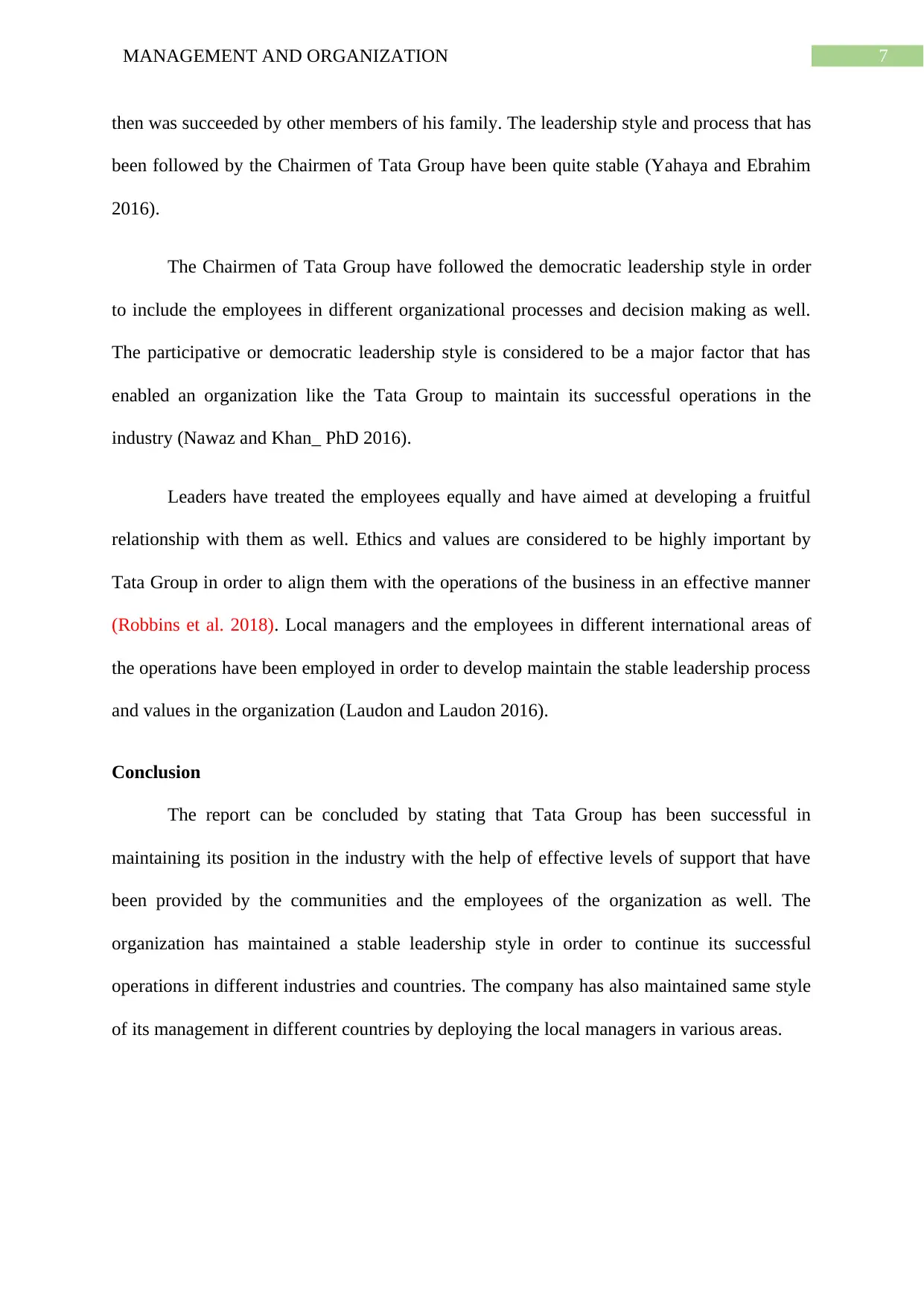
7MANAGEMENT AND ORGANIZATION
then was succeeded by other members of his family. The leadership style and process that has
been followed by the Chairmen of Tata Group have been quite stable (Yahaya and Ebrahim
2016).
The Chairmen of Tata Group have followed the democratic leadership style in order
to include the employees in different organizational processes and decision making as well.
The participative or democratic leadership style is considered to be a major factor that has
enabled an organization like the Tata Group to maintain its successful operations in the
industry (Nawaz and Khan_ PhD 2016).
Leaders have treated the employees equally and have aimed at developing a fruitful
relationship with them as well. Ethics and values are considered to be highly important by
Tata Group in order to align them with the operations of the business in an effective manner
(Robbins et al. 2018). Local managers and the employees in different international areas of
the operations have been employed in order to develop maintain the stable leadership process
and values in the organization (Laudon and Laudon 2016).
Conclusion
The report can be concluded by stating that Tata Group has been successful in
maintaining its position in the industry with the help of effective levels of support that have
been provided by the communities and the employees of the organization as well. The
organization has maintained a stable leadership style in order to continue its successful
operations in different industries and countries. The company has also maintained same style
of its management in different countries by deploying the local managers in various areas.
then was succeeded by other members of his family. The leadership style and process that has
been followed by the Chairmen of Tata Group have been quite stable (Yahaya and Ebrahim
2016).
The Chairmen of Tata Group have followed the democratic leadership style in order
to include the employees in different organizational processes and decision making as well.
The participative or democratic leadership style is considered to be a major factor that has
enabled an organization like the Tata Group to maintain its successful operations in the
industry (Nawaz and Khan_ PhD 2016).
Leaders have treated the employees equally and have aimed at developing a fruitful
relationship with them as well. Ethics and values are considered to be highly important by
Tata Group in order to align them with the operations of the business in an effective manner
(Robbins et al. 2018). Local managers and the employees in different international areas of
the operations have been employed in order to develop maintain the stable leadership process
and values in the organization (Laudon and Laudon 2016).
Conclusion
The report can be concluded by stating that Tata Group has been successful in
maintaining its position in the industry with the help of effective levels of support that have
been provided by the communities and the employees of the organization as well. The
organization has maintained a stable leadership style in order to continue its successful
operations in different industries and countries. The company has also maintained same style
of its management in different countries by deploying the local managers in various areas.

8MANAGEMENT AND ORGANIZATION
References
Anderson, M.H. and Sun, P.Y., 2017. Reviewing leadership styles: Overlaps and the need for
a new ‘full‐range’theory. International Journal of Management Reviews, 19(1), pp.76-96.
Ansoff, H.I., Kipley, D., Lewis, A.O., Helm-Stevens, R. and Ansoff, R., 2018. Implanting
strategic management. Springer.
Arnold, K.A., Connelly, C.E., Walsh, M.M. and Martin Ginis, K.A., 2015. Leadership styles,
emotion regulation, and burnout. Journal of Occupational Health Psychology, 20(4), p.481.
Cashman, K., 2017. Leadership from the inside out: Becoming a leader for life. Berrett-
Koehler Publishers.
Covin, J.G. and Slevin, D.P., 2017. The entrepreneurial imperatives of strategic
leadership. Strategic entrepreneurship: Creating a new mindset, pp.307-327.
Grint, K., Jones, O.S. and Holt, C., 2016. What is Leadership. The Routledge Companion to
Leadership, p.3.
Heifetz, R. and Linsky, M., 2017. Leadership on the line, with a new preface: Staying alive
through the dangers of change. Harvard Business Press.
Jaques, E., 2017. Requisite organization: A total system for effective managerial
organization and managerial leadership for the 21st century. Routledge.
Laudon, K.C. and Laudon, J.P., 2016. Management information system. Pearson Education
India.
Mendenhall, M.E., Osland, J., Bird, A., Oddou, G.R., Stevens, M.J., Maznevski, M. and
Stahl, G.K. eds., 2017. Global leadership: Research, practice, and development. Routledge.
References
Anderson, M.H. and Sun, P.Y., 2017. Reviewing leadership styles: Overlaps and the need for
a new ‘full‐range’theory. International Journal of Management Reviews, 19(1), pp.76-96.
Ansoff, H.I., Kipley, D., Lewis, A.O., Helm-Stevens, R. and Ansoff, R., 2018. Implanting
strategic management. Springer.
Arnold, K.A., Connelly, C.E., Walsh, M.M. and Martin Ginis, K.A., 2015. Leadership styles,
emotion regulation, and burnout. Journal of Occupational Health Psychology, 20(4), p.481.
Cashman, K., 2017. Leadership from the inside out: Becoming a leader for life. Berrett-
Koehler Publishers.
Covin, J.G. and Slevin, D.P., 2017. The entrepreneurial imperatives of strategic
leadership. Strategic entrepreneurship: Creating a new mindset, pp.307-327.
Grint, K., Jones, O.S. and Holt, C., 2016. What is Leadership. The Routledge Companion to
Leadership, p.3.
Heifetz, R. and Linsky, M., 2017. Leadership on the line, with a new preface: Staying alive
through the dangers of change. Harvard Business Press.
Jaques, E., 2017. Requisite organization: A total system for effective managerial
organization and managerial leadership for the 21st century. Routledge.
Laudon, K.C. and Laudon, J.P., 2016. Management information system. Pearson Education
India.
Mendenhall, M.E., Osland, J., Bird, A., Oddou, G.R., Stevens, M.J., Maznevski, M. and
Stahl, G.K. eds., 2017. Global leadership: Research, practice, and development. Routledge.
⊘ This is a preview!⊘
Do you want full access?
Subscribe today to unlock all pages.

Trusted by 1+ million students worldwide
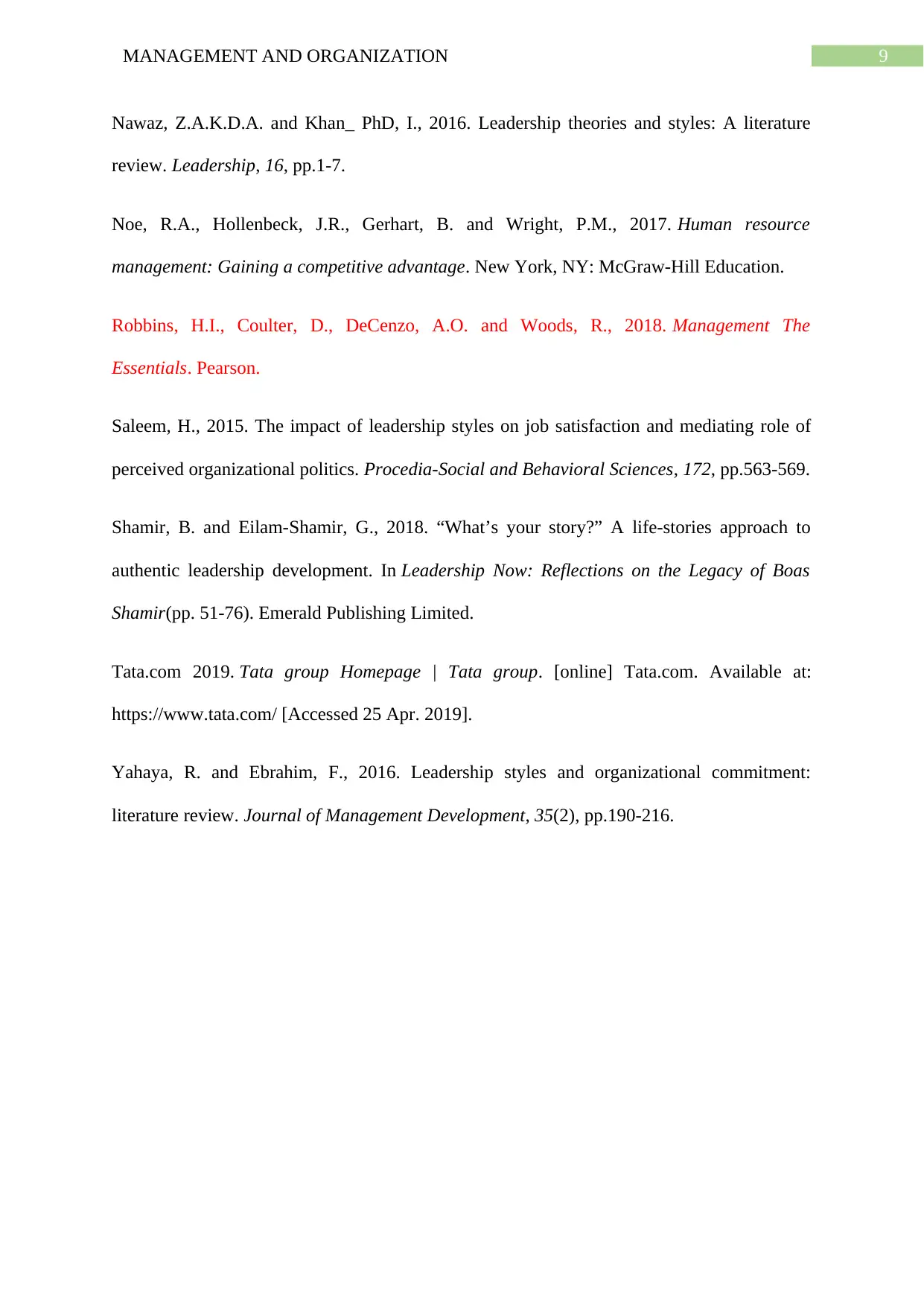
9MANAGEMENT AND ORGANIZATION
Nawaz, Z.A.K.D.A. and Khan_ PhD, I., 2016. Leadership theories and styles: A literature
review. Leadership, 16, pp.1-7.
Noe, R.A., Hollenbeck, J.R., Gerhart, B. and Wright, P.M., 2017. Human resource
management: Gaining a competitive advantage. New York, NY: McGraw-Hill Education.
Robbins, H.I., Coulter, D., DeCenzo, A.O. and Woods, R., 2018. Management The
Essentials. Pearson.
Saleem, H., 2015. The impact of leadership styles on job satisfaction and mediating role of
perceived organizational politics. Procedia-Social and Behavioral Sciences, 172, pp.563-569.
Shamir, B. and Eilam-Shamir, G., 2018. “What’s your story?” A life-stories approach to
authentic leadership development. In Leadership Now: Reflections on the Legacy of Boas
Shamir(pp. 51-76). Emerald Publishing Limited.
Tata.com 2019. Tata group Homepage | Tata group. [online] Tata.com. Available at:
https://www.tata.com/ [Accessed 25 Apr. 2019].
Yahaya, R. and Ebrahim, F., 2016. Leadership styles and organizational commitment:
literature review. Journal of Management Development, 35(2), pp.190-216.
Nawaz, Z.A.K.D.A. and Khan_ PhD, I., 2016. Leadership theories and styles: A literature
review. Leadership, 16, pp.1-7.
Noe, R.A., Hollenbeck, J.R., Gerhart, B. and Wright, P.M., 2017. Human resource
management: Gaining a competitive advantage. New York, NY: McGraw-Hill Education.
Robbins, H.I., Coulter, D., DeCenzo, A.O. and Woods, R., 2018. Management The
Essentials. Pearson.
Saleem, H., 2015. The impact of leadership styles on job satisfaction and mediating role of
perceived organizational politics. Procedia-Social and Behavioral Sciences, 172, pp.563-569.
Shamir, B. and Eilam-Shamir, G., 2018. “What’s your story?” A life-stories approach to
authentic leadership development. In Leadership Now: Reflections on the Legacy of Boas
Shamir(pp. 51-76). Emerald Publishing Limited.
Tata.com 2019. Tata group Homepage | Tata group. [online] Tata.com. Available at:
https://www.tata.com/ [Accessed 25 Apr. 2019].
Yahaya, R. and Ebrahim, F., 2016. Leadership styles and organizational commitment:
literature review. Journal of Management Development, 35(2), pp.190-216.
1 out of 10
Related Documents
Your All-in-One AI-Powered Toolkit for Academic Success.
+13062052269
info@desklib.com
Available 24*7 on WhatsApp / Email
![[object Object]](/_next/static/media/star-bottom.7253800d.svg)
Unlock your academic potential
Copyright © 2020–2025 A2Z Services. All Rights Reserved. Developed and managed by ZUCOL.




